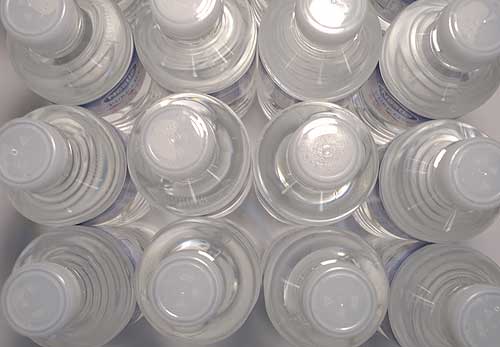 by Preston MacDougall November 12, 2007
However, rather than courting disaster, chasing arrows is one of the keys to averting it. How so? Look at the bottom of virtually any plastic container, and there they are - three arrows that appear to be chasing each other in a square dance that's short a dancer. Less dynamically, this familiar symbol is officially called the SPI resin identification code, named after its developers - the Society of the Plastics Industry.  Credit: morguefile.com
If you see an empty bottle of Dr. Pepper on the ground, pick it up and turn it over and you'll see the arrows chasing each other around a 1. On some bottles, you'll also see the acronym for polyethylene terephthalate - PET. Phthalates belong to the class of organic compounds called esters, so plastics made from them are technically "polyesters" where the prefix poly simply means "many joined together". Polyesters are a common form of organic matter. In addition to their use as an economical if not always stylish fabric, they are also produced naturally by some bacteria. Phthalates in particular are often blended with other plastics to make them more pliable, just like your lips and tongue need to be in order to pronounce these names that begin with phth. Some studies have implicated the leaching of these phthalate additives as a health hazard to young children who can be quite unhappy without something soft and plastic in their mouth. Perhaps to seem friendlier (and to avoid reminding you about the possibility of very low-levels of phthalates in your Dr. Pepper), instead of using the complete acronym of PETP, some bottlers add an extra E to spell out PETE. Polyethylene terephthalate has all sorts of uses. Market studies indicate that it is something that people enjoy having a beer in, and gladly take it along on a barbecue picnic. Texas Pete is even the name of a top-selling brand of hot sauce. But don't believe everything you eat. Texas Pete is a North Carolina-style barbecue sauce, and is more "runny" than Western styles. There is probably some polymer chemistry in the different textures of barbecue sauces - with longer polysaccharides being more common the further West your chuckwagon goes - but let's get back to the Dr. Pepper bottle. According to company lore, Dr. Pepper was invented by a young pharmacist in Waco, Texas. There is some chance that our empty bottle originated there too. To explain that, it helps to recall "a story about a man named Jed". As the story goes, "one day he was shootin at some food, When up from the ground came-a bubblin crude. Oil, that is. Black gold. Texas tea." PET, and almost all other plastic resins, begin their synthetic life as crude oil. Crude oil is a complex mixture of many chemical compounds, most of them hydrocarbons. Hydrocarbons are a virtually innumerable class of chemical compounds that contain just the elements carbon and hydrogen. In esters, however, a small fraction of the atoms are oxygen, and they must be positioned in a certain way relative to their carbon neighbors. Such atomic insertions, done with nano-scale precision on the kiloton scale, is the cornbread and butter of the bulk chemical industry. The world leader in PET production has long been Eastman Chemical, which is headquartered in the green hills of East Tennessee. (This may or may not be where Jed is from - that's a Hollywood secret.) To encourage you to recycle that empty bottle of Dr. Pepper, or that empty milk jug (SPI code 2 - polyethylene without the esters), consider this last stat. While Houston may still be considered by some as the "oil capital of the world", most of the world's oil does not come from Texas anymore. It comes from a place where a modern-day Custer could easily find lots of insurgents.
On the Web:
E-mail your letters & opinions to editor@sitnews.us SitNews ©2007 Stories In The News Ketchikan, Alaska |